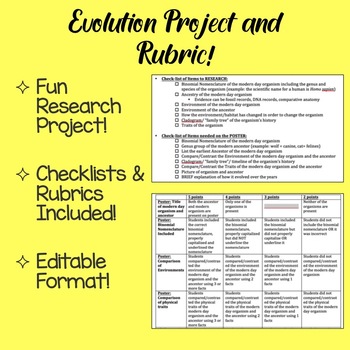Evolution Project and Rubric- Distance Learning
- Zip
What educators are saying
Description
Teachers can use this Evolution Project and Rubric to allow students to explore the evolutionary changes of an organism of their choice. Students will choose an organism, research its ancestry, create a poster with specific guidelines, and present their findings to the class. A rubric is included in this product to serve as a guideline for both teachers and students alike. This format is editable, so more/less can be altered to the directions and rubric. Information such as incorporating binomial nomenclature, cladograms/family trees, comparing and contrasting environments and physical traits are focal points for this product.
This product also includes a checklist for: the research process- to ensure students find appropriate information, poster design components and presentation discussion points. The rubric is also designed by a point system with scales going from 5 to 2. (This can be altered to your school rubric guidelines if needed.)
*Updated 3/24/202 to allow individual students to complete the project solo for distant learning opportunities! An essay is required vs an in person presentation.
*Updated on 5/15/2020 to include NGSS for both middle school and high school!
*Updated on 5/16/2021 to include more checklist items for students to research and include within their presentations (for both versions). Also updated the rubric to include points for the bibliography component. Total rubric points are now out of 55- this is due to the new bibliography section as well as making the explanation of evolution segment worth 10 points vs 5.


